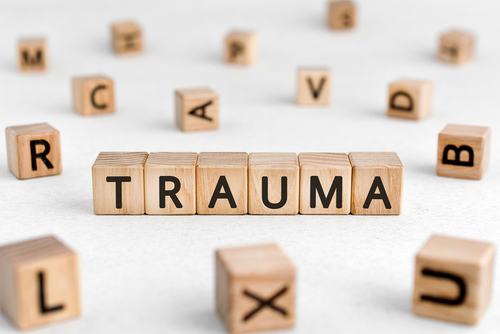By Dr. Kelly O’Connor, PhD, LCP, Licensed Clinical Psychologist at CAYA Care
What is trauma?
Trauma is an event or series of events that involve fear or threat to a person. This includes experiences such as abuse, losing a loved one suddenly, getting in a serious accident, and witnessing violence. When a child is impacted by trauma, it can affect many areas of their life. The most common symptoms include:
- Upsetting thoughts about the traumatic event(s)
- Bad dreams or sleep problems
- Bad memories (or “flashbacks”) that make it feel like the trauma is happening all over again
- Avoiding things that remind them of the traumatic event(s)
- Being more easily startled, scared, or anxious
- Feeling much more sad, angry, irritable, or not being able to enjoy things like they did before
- Unable to remember some parts of what happened
What is traumatic stress?
“Traumatic stress” is the umbrella term that therapists use to refer to the symptoms listed above when they are related to a traumatic event. In addition to traumatic stress, kids and teens will often experience other mental health problems after trauma exposure such as depression, anxiety, behavior problems, relationship problems, school problems, and more.
What makes traumatic stress so pervasive is that it is perpetuated by memories of one or more traumatic events and the thoughts and feelings associated with the event(s). Since we can’t erase our memories, often times kids (and adults too!) will try very hard not to think about what happened because of the distress it causes them. However, every time someone avoids a situation, person, or other thing that reminds them of the traumatic event, they are actually “reinforcing” their stress response. Put differently, trauma can create a false alarm system in a child’s brain. When faced with a reminder of the trauma, the alarm system is set off, enacting a series of psychological and physiological stress responses—the same ones we all experience in threatening or dangerous situations. The problem is that the false alarm system created by the trauma can often be set off by things, places, and people that are not actually dangerous. When the trauma reminder and the associated distress is avoided, the the alarm system becomes more sensitive because the body has learned that the person, place, or thing that was avoided is indeed something to be fearful of, even if it is not really dangerous or threatening.
For example, imagine a boy was recently in a serious car accident. When his mother asked him to come grocery shopping with her, he refused to get in the car. His mother did not want to see him upset given the recent accident, which is a common reaction for parents of trauma-exposed youth, so she allowed her son to stay home with his grandma while she went to the store. When she needed her son to get in the car for a doctor appointment a few days later, he felt even more distressed about getting into the car than he did before and began to throw a tantrum. As the cycle of avoidance repeats over time, reminders of the traumatic event become more and more distressing until the individual’s ability to function in their everyday life is significantly reduced. When an individual experiences traumatic stress for more than a few weeks and it affects their ability to function, they may meet criteria for Posttraumatic Stress Disorder (or PTSD). However, a child does not need to meet criteria for PTSD in order to benefit from trauma-focused cognitive behavior therapy.

What is Trauma-focused cognitive behavior therapy (TF-CBT)?
TF-CBT is an evidence-based treatment for kids and teens impacted by trauma. It has the strongest research evidence of any treatment model for trauma-exposed kids and teens (de Arellano et al., 2014). TF-CBT pairs common components of cognitive-behavioral therapies with trauma-focused components to comprehensively address traumatic stress symptoms and co-occurring mental health problems. For example, an important part of TF-CBT and many other cognitive-behavioral treatment approaches is teaching kids and teens skills to regulate their emotions, thoughts, and behaviors, which can reduce their symptoms of traumatic stress, depression, and anxiety. However, these skills alone are not typically sufficient to alleviate traumatic stress.
TF-CBT includes trauma-focused components that involve exposing kids and teens to the distressing memories of traumatic event(s). This is effective because exposure is the opposite of avoidance, which can worsen traumatic stress as noted above. While this is often a challenging part of treatment for kids, it is also one in which they show the greatest reductions in traumatic stress symptoms. Therapists are well-equipped with techniques to ensure that kids can cope with the distress they experience as they recall their trauma memories. Kids are never rushed or pushed into talking about things that they aren’t ready to talk about yet. More importantly, therapists help kids process their thoughts and feelings related to the traumatic event, which allows them to view the event from a more helpful or healthy perspective. For example, a therapist can help a child who experienced sexual abuse understand that the abuse was not their fault even if they did not say no. Kids and teens who are artistic or musical can opt to draw or rap about their memories rather than writing them. TF-CBT can also be modified to address the needs of Spanish-speaking, Native American, deaf and hearing impaired, and many other populations.
Research has shown that TF-CBT can improve traumatic stress symptoms, depression, anxiety symptoms, behavior problems (including sexualized behavior problems), shame, trauma-related thoughts, interpersonal trust, and social skills (Cohen & Mannarino, 2017; Cohen et al., 2011; Lenz & Hollenbaugh, 2015). Parents and caregivers play an important role in several components of TF-CBT and, as a result, they also experience benefits. Research has found that parents and caregivers report less emotional distress and depressive symptoms and improve their ability to support their child and manage behavioral difficulties (Deblinger et al., 2015).
You should consult with a licensed mental health professional to determine whether TF-CBT is a good fit for your child. For those interested in receiving treatment at CAYA, Dr. Kelly O’Connor specializes in TF-CBT. Below are additional resources for parents and caregivers about trauma and trauma-focused treatment for kids and teens:
- The National Child Traumatic Stress Network: https://www.nctsn.org/audiences/families-and-caregivers
- American Academy of Pediatrics: https://www.aap.org/en/patient-care/trauma-informed-care/resources-for-families/
- American Academy of Child and Adolescent Psychiatry: https://www.aacap.org/AACAP/Families_and_Youth/Resource_Centers/Disaster_Resource_Center/Resources_for_Parents_Disaster.aspx
References
Cohen, J. A., Mannarino, A. P., & Deblinger, E. (2017). Treating trauma and traumatic grief in children and adolescents (2nd ed.). New York: Guilford.
Cohen, J. A., Mannarino, A. P., & Iyengar, S. (2011). Community treatment of posttraumatic stress disorder for children exposed to intimate partner violence. Archives of Pediatrics & Adolescent Medicine, 165(1), 16–21. https://doi.org/10.1001/archpediatrics.2010.247
de Arellano, M. A., Lyman, D. R., Jobe-Shields, L., George, P., Dougherty, R. H., Daniels, A. S., Ghose, S. S., Huang, L., & Delphin-Rittmon, M. E. (2014). Trauma-Focused Cognitive Behavioral Therapy: Assessing the Evidence. Psychiatric Services, 65(5), 591–602. https://doi.org/10.1176/appi.ps.201300255
Deblinger, E., Mannarino, A. P., Cohen, J. A., Runyon, M. K., & Heflin, A. H. (2015). Child sexual abuse: A primer for treating children, adolescents, and their nonoffending parents (2nd ed.). New York: Oxford University Press.
Lenz, A. S., & Hollenbaugh, K. M. (2015). Meta-analysis of trauma-focused cognitive behavioral therapy for treating PTSD and co-occuring depression among children and adolescents. Counseling Outcome Research and Evaluation, 6, 18–32. https://doi.org/10.1177/2150137815573790



